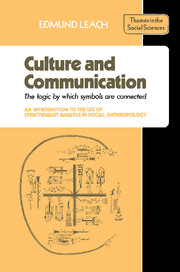 Culture and Communication
Culture and Communication Book contents
- Frontmatter
- Contents
- Culture and communication: the logic by which symbols are connected
- Introduction
- 1 Empiricists and rationalists: economic transactions and acts of communication
- 2 Problems of terminology
- 3 Objects, sense-images, concepts
- 4 Signals and indices
- 5 Transformations
- 6 Theories of magic and sorcery
- 7 The symbolic ordering of a man-made world: boundaries of social space and time
- 8 The material representation of abstract ideas: ritual condensation
- 9 Orchestral performance as a metaphor for ritual sequence
- 10 The physiological basis of sign/symbol sets
- 11 Mapping: time and space as reciprocal representations
- 12 Rank order and orientation
- 13 Examples of binary coding
- 14 Mating prescriptions and proscriptions
- 15 Logic and mytho-logic
- 16 Basic cosmology
- 17 Rites of transition (rites de passage)
- 18 The logic of sacrifice
- 19 Conclusion
- Bibliography
- Index
15 - Logic and mytho-logic
Published online by Cambridge University Press: 05 June 2012
- Frontmatter
- Contents
- Culture and communication: the logic by which symbols are connected
- Introduction
- 1 Empiricists and rationalists: economic transactions and acts of communication
- 2 Problems of terminology
- 3 Objects, sense-images, concepts
- 4 Signals and indices
- 5 Transformations
- 6 Theories of magic and sorcery
- 7 The symbolic ordering of a man-made world: boundaries of social space and time
- 8 The material representation of abstract ideas: ritual condensation
- 9 Orchestral performance as a metaphor for ritual sequence
- 10 The physiological basis of sign/symbol sets
- 11 Mapping: time and space as reciprocal representations
- 12 Rank order and orientation
- 13 Examples of binary coding
- 14 Mating prescriptions and proscriptions
- 15 Logic and mytho-logic
- 16 Basic cosmology
- 17 Rites of transition (rites de passage)
- 18 The logic of sacrifice
- 19 Conclusion
- Bibliography
- Index
Summary
I want now to return to the problem which I raised earlier (Section 6) of how far we can distinguish the logic of technical actions from the pseudo-logic of expressive actions.
In our own Western, literate, mechanically organised society, so much ‘true’ Aristotelian logic is built into the cultural system that we mostly take it for granted that logic of this kind is an essential component of common sense. Yet in practice we only exploit formal logical principles in the relatively rare instances in which we are seeking to convey exact information at a distance using a single channel of communication, as in writing a letter or a book or speaking to someone over the telephone. When two people are in face to face communication, so that they can use several channels of sensory information simultaneously – touch, sight, hearing and so on – the logical ordering of individual messages is much less obvious.
If you record unrehearsed conversation on tape you will find that on play-back very little of it is immediately comprehensible; yet, in context, all those present would have understood what was being said. This is because, in its original setting, the spoken utterance was only part of a larger whole. It had a metonymic (sign) relationship with everything else that was going on in the room at the same time, and this non-verbal ‘other’ was also conveying part of the message.
But the same argument applies the other way round. When an anthropologist tries to decode a set of non-verbal indices he needs to remember that he has only got part of the evidence.
- Type
- Chapter
- Information
- Culture and CommunicationThe Logic by which Symbols Are Connected. An Introduction to the Use of Structuralist Analysis in Social Anthropology, pp. 69 - 70Publisher: Cambridge University PressPrint publication year: 1976


